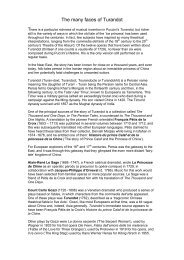NEF-Southampton-Positive-Money-ICB-Submission
NEF-Southampton-Positive-Money-ICB-Submission
NEF-Southampton-Positive-Money-ICB-Submission
Create successful ePaper yourself
Turn your PDF publications into a flip-book with our unique Google optimized e-Paper software.
Benefits of Full-‐Reserve Banking over AlternaPve Reforms<br />
No Need to Back Retail Deposits with Government Debt<br />
With our model of full-‐reserve banking, members of the public are able to use risk-‐free, digital central bank<br />
money in their TransacGon Accounts. TransacGon Accounts are held off the balance sheet, and therefore<br />
there is no need for a backing asset, meaning that our full-‐reserve banking proposal does not require retail<br />
deposits to be backed by government debt.<br />
InteresGngly, backing retail deposits with government debt is illogically circular, since government debt is, in<br />
effect, backed by the government’s ability to collect retail deposits from the public via taxaGon. In other<br />
words, under proposals by Kay and Kotlikoff, retail deposits would – ulGmately – be backed by retail deposits.<br />
Lack Of Need For Limits on Proprietary Trading and InvesPng<br />
We can require that banks disclose the intended use of money invested in each type of Investment Account,<br />
and that they ring-‐fence this money appropriately. Doing so would mean that banks that wanted to engage in<br />
proprietary trading and invesGng would be able to do so, but only with funds that investors agreed to have<br />
used in this way. In other words, savers/investors who were happy to accept the risks that come with<br />
proprietary trading or invesGng, and were fully aware that there would be no government-‐funded<br />
compensaGon if the investments lost money, would be able to provide the funds for such acGviGes. Banks<br />
would be able to engage in proprietary trading, but would need to bid for those funds from members of the<br />
public at a price (interest rate) that reflects the risk. This fact would probably reduce the overall amount of<br />
funds that banks can put into proprietary trading and therefore reduce instability from speculaGve trading.<br />
This system would mean that proprietary trading and invesGng could conGnue within the same enGty as a<br />
normal retail bank, without exposing the payments system to any risk.<br />
Lack of Need for SeparaPon of Retail and Investment Banking<br />
As outlined, we can require banks to disclose the intended use of money invested in each type of Investment<br />
Account. If we did this, investment banking could conGnue within the same legal enGty as a commercial bank,<br />
but only with funds that the savers/investors wish to have used for investment banking.<br />
Minimum DisrupPon For Members of the Public<br />
In contrast to the Limited Purpose Banking proposal, which requires all investments to be made through<br />
mutual funds, members of the public would find it very easy to adapt to the new TransacGon Accounts and<br />
Investment Accounts, which are almost idenGcal to present-‐day ‘current accounts’ and ‘savings accounts’.<br />
No Loss of Synergies Between Deposit-‐Taking and Bank Lending<br />
With our model of full-‐reserve banking, the same legal enGty can provide payment services along with<br />
investment and lending services. The same bank branch could therefore provide all the services that the<br />
average member of the public needed, and therefore the synergies between these different services are<br />
preserved.<br />
17



